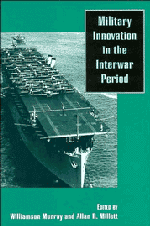Book contents
- Frontmatter
- Contents
- Acknowledgments
- Introduction
- 1 Armored warfare: The British, French, and German experiences
- 2 Assault from the sea: The development of amphibious warfare between the wars – the American, British, and Japanese experiences
- 3 Strategic bombing: The British, American, and German experiences
- 4 Close air support: The German, British, and American experiences, 1918–1941
- 5 Adopting the aircraft carrier: The British, American, and Japanese case studies
- 6 Innovation ignored: The submarine problem – Germany, Britain, and the United States, 1919–1939
- 7 From radio to radar: Interwar military adaptation to technological change in Germany, the United Kingdom, and the United States
- 8 Innovation: Past and future
- 9 Patterns of military innovation in the interwar period
- 10 Military innovation in peacetime
- Index
3 - Strategic bombing: The British, American, and German experiences
Published online by Cambridge University Press: 05 August 2012
- Frontmatter
- Contents
- Acknowledgments
- Introduction
- 1 Armored warfare: The British, French, and German experiences
- 2 Assault from the sea: The development of amphibious warfare between the wars – the American, British, and Japanese experiences
- 3 Strategic bombing: The British, American, and German experiences
- 4 Close air support: The German, British, and American experiences, 1918–1941
- 5 Adopting the aircraft carrier: The British, American, and Japanese case studies
- 6 Innovation ignored: The submarine problem – Germany, Britain, and the United States, 1919–1939
- 7 From radio to radar: Interwar military adaptation to technological change in Germany, the United Kingdom, and the United States
- 8 Innovation: Past and future
- 9 Patterns of military innovation in the interwar period
- 10 Military innovation in peacetime
- Index
Summary
Throughout the twentieth century, fundamental changes in how wars between nations are fought have been influenced by a variety of political, technological, geostrategic, and cultural factors that have been largely external to military services and organizations. For instance, technological changes affecting the weapons and other tools employed in military operations have usually been part of the external environment in which peacetime military innovation occurred, not indigenous to military organizations themselves.
Of all the military innovations during the years 1918–1939, strategic bombing was particularly influenced by these kinds of external factors. There are a number of reasons why this should be so; among other factors the rapid development of aviation technology as well as the catastrophic impact of World War I on Western civilization exercised a crucial impact on the minds of airmen, politicians, and ordinary citizens alike. Such societal and intellectual influences in turn influenced development of the doctrines and conceptions with which military organizations approached the question of strategic bombing.
Much of air power's appeal to military and political leaders lay in its potential to combine physical destruction with the reach and speed to overfly intervening oceans, plains, rivers, and mountains and focus that destructive power against the vital centers of the enemy nation in a matter of hours. Above all, this sort of strategic use of air power seemed to offer an escape from another terrible war of attrition on the ground.
- Type
- Chapter
- Information
- Military Innovation in the Interwar Period , pp. 96 - 143Publisher: Cambridge University PressPrint publication year: 1996
- 5
- Cited by

